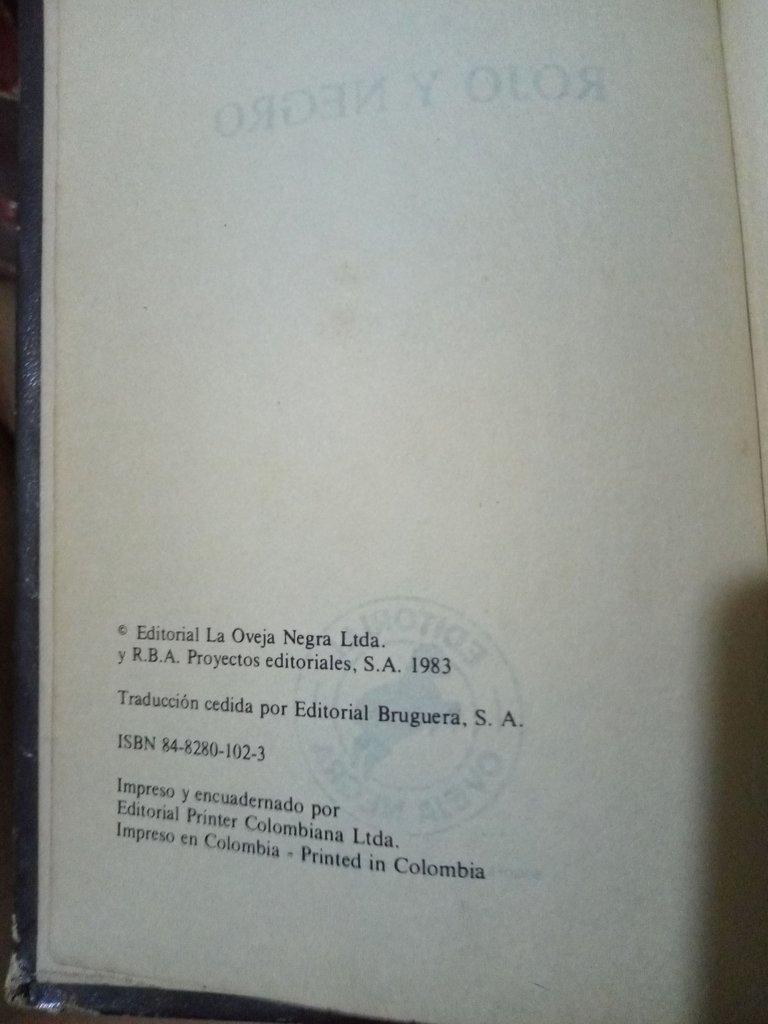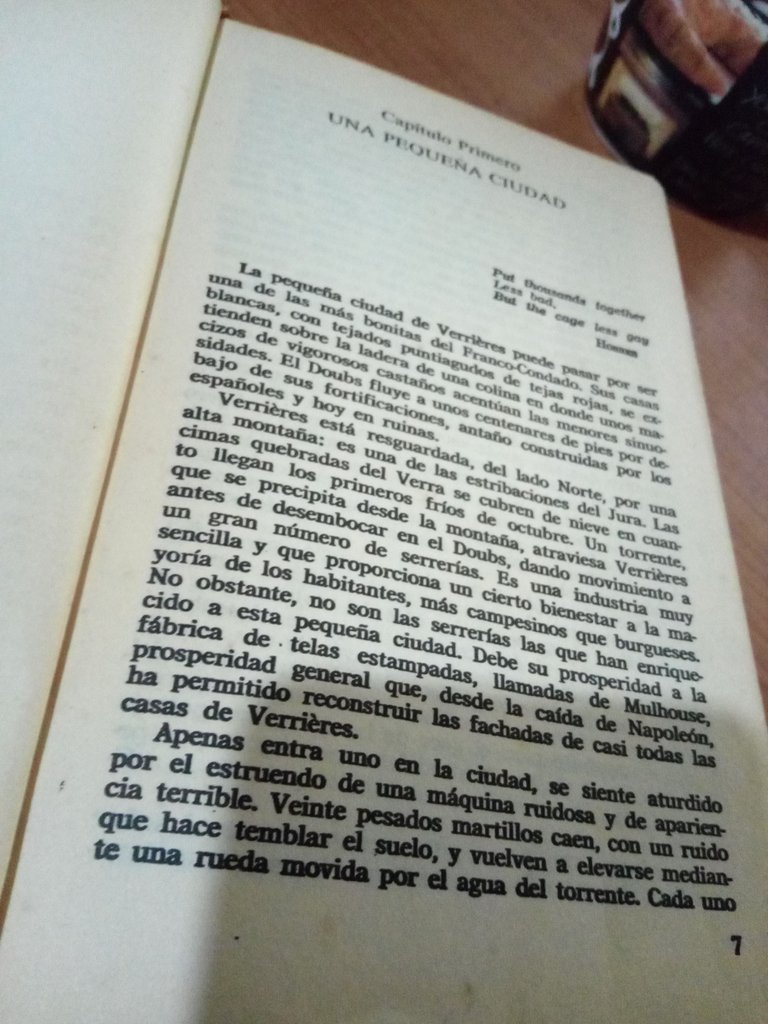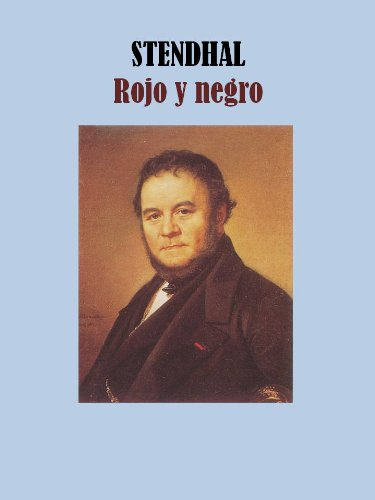
Link

Hola amigos lectores, Ante todo un cordial saludo espero se encuentren con bien y en plena salud, este dia les hablare de un libro que para muchos es un clásico de la literatura, esta es La novela Rojo y Negro de Stendhal fue escrita y narrada sobre las vivencia del joven Julien Sorel, durante los últimos años de la Restauración borbónica, el escritor narra los hechos como si los vive o lo lee, viendo y demostrando que conoce de la situación social y política que se vive en Francia en ese momento,se detalla que el autor le dio verdadera importancia, e puede decir, que es una novela de su tiempo.
Hello fellow readers, First of all a cordial greeting I hope you are well and in full health, this day I will talk about a book that for many is a classic of literature, this is The novel Stendhal's Rojo y Negro was written and narrated about the experiences of the young Julien Sorel, during the last years of the Bourbon Restoration, the writer narrates the facts as if he lived or reads them, seeing and showing that he knows about the social and political situation living in France at that time, it is detailed that the author gave it real importance, and it can be said that it is a novel of his time.

Rojo y Negro, su nombre original era “Le Rouge et le Noir: chronique du XIX. Siecle” y luego lo cambiaron a “Le Rouge et le Noir: chronique de 1830”. Esta novela ha influido a escritores como León Tolstói y en el siglo XX a Andrés Gide.
Red and Black, its original name was “Le Rouge et le Noir: chronique du XIX. Siecle ”and then changed it to“ Le Rouge et le Noir: chronique de 1830 ”. This novel has influenced writers such as León Tolstoy and, in the 20th century, Andrés Gide.

El autor de la novela Rojo y Negro se llamó Marie Henri Beyle, seudónimo Stendhal, nació en Francia y vivió entre los años de 1783 y 1842. Abandonó su casa a los 16 años. Inició sus estudios en el seminario para cursar la carrera del sacerdocio, cambiando luego para terminar sus estudios en un colegio laico, siendo menor de edad se alistó en el ejército de Napoleón, con que recorrió Alemania, Austria y Rusia para luego finalizar su carrera militar en 1802. Con la caída de Napoleón Bonaparte, se marchó a Italia, en ese país se interesó en el arte y empezó a escribir, en Italia escribió dos libros uno titulado: Historia de la pintura italiana en 1817, firmando Stendhal, y Vida de Napoleón. Una vez terminada las persecuciones políticas a los partidarios Napoleón, se regresó para Francia y se fue a vivir a París para dedicarse de lleno a la escritura. Retorno a Italia, cuando lo nombraron Cónsul de Francia en Italia, en este país publicó las novelas que le hicieron famosos: El rojo y el negro en 1830 y La cartuja de Parma en 1839. Entre sus obras también destacan sus escritos autobiográficos, Vida de Henry Brulard y Recuerdos de egotismo, Regresó a París y en 1837 publicó una de sus últimas obras, Memorias sobre Napoleón. Luego de ser cónsul en Trieste y Civitavecchia, en 1841 regresó a París, donde murió un año más tarde. Fue uno de los escritores más influyentes del siglo XIX.
The author of the novel Red and Black was called Marie Henri Beyle, pseudonym Stendhal, was born in France and lived between the years of 1783 and 1842. He left home at the age of 16. He began his studies at the seminary to pursue the career of the priesthood, later changing to finish his studies in a secular school, being a minor he enlisted in Napoleon's army, with which he toured Germany, Austria and Russia to later finish his military career in 1802. With the fall of Napoleon Bonaparte, he went to Italy, in that country he became interested in art and began to write, in Italy he wrote two books, one entitled: History of Italian painting in 1817, signing Stendhal, and Life of Napoleon. Once the political persecutions of the Napoleon supporters ended, he returned to France and went to live in Paris to dedicate himself fully to writing. Return to Italy, when he was appointed Consul of France in Italy, in this country he published the novels that made him famous: The Red and the Black in 1830 and The Charterhouse of Parma in 1839. His autobiographical writings, Vida de Henry Brulard and Memories of egotism, returned to Paris and in 1837 published one of his last works, Memoirs on Napoleon. After being consul in Trieste and Civitavecchia, in 1841 he returned to Paris, where he died a year later. He was one of the most influential writers of the 19th century.
Es un buen libro a mi se me hizo un poco largo aunque me sorprendió que todo se resolviera en las ultimas paginas, me sorprende aun mas que estuviera basado en una historia real. puedo decir que su Prosa es muy elaborada, lento y en algunas partes hasta redundante, Me gustó mucho y creo que fue muy bien construido en cuanto a cada detalle el personaje principal, en algunas partes de la historia me cayo mal aunque comprendí la narrativa! No es mi estilo de lectura aunque me gusto, fue totalmente diferente a lo que esperaba al comenzar a leer. Para muchos esta es una de las mayores exponentes del realismo francés en el siglo XIX, donde el autor ofrece en una crónica realista de la sociedad aristocrática francesa, que fue marcada por el cinismo político de una manera realista y con cierto grado de romanticismo
It is a good book to me it seemed a bit long although I was surprised that everything was resolved in the last pages, it surprises me even more that it was based on a true story. I can say that his Prose is very elaborate, slow and in some parts even redundant, I liked it a lot and I think the main character was very well constructed in terms of every detail, in some parts of the story I didn't like it even though I understood the narrative! It is not my reading style although I liked it, it was totally different from what I expected when I started reading. For many this is one of the greatest exponents of French realism in the nineteenth century, where the author offers in a realistic chronicle of French aristocratic society, which was marked by political cynicism in a realistic way and with a certain degree of romanticism

Ambientada en el período de restauración (1814-1830) en Francia (es decir, la restauración de la monarquía borbónica en el poder después de la caída de Napoleón Bonaparte), es una historia de hazañas de escalada social y de dos búsquedas amorosas distintas de personas de bajos recursos. el protagonista Julien Sorel desde un vívido punto de vista psicoanalítico, entretejido a través de un tejido social y político de rica textura con un trasfondo satírico. Este tejido, único en el sentido histórico, refleja las disputas en curso por la riqueza y el poder, a menudo empañadas por la hipocresía, la codicia, la corrupción, la adulación y las disputas, entre los principales actores de la sociedad, a saber: el clero, los aristócratas pro-borbones ( llamados "legitimistas"), ministros y advenedizos provinciales. Este era el orden del día de la monarquía constitucional en la época de la Restauración. El mensaje arraigado de la novela es que no había lugar en el círculo de las partes interesadas para la clase plebeya en ese momento. En este sentido, la novela casi alude al gran descontento social que se estaba gestando y que, en realidad, condujo a la ruptura definitiva de la monarquía borbónica.
Set in the restoration period (1814-1830) in France (that is, the restoration of the Bourbon monarchy to power after the fall of Napoleon Bonaparte), it is a tale of exploits of social escalation and of two different love searches of low-income people. the protagonist Julien Sorel from a vivid psychoanalytic point of view, woven through a richly textured social and political fabric with a satirical undertone. This fabric, unique in the historical sense, reflects the ongoing disputes over wealth and power, often clouded by hypocrisy, greed, corruption, adulation and squabbles, between the main actors in society, namely : the clergy, pro-Bourbon aristocrats (called "loyalists"), ministers and provincial upstarts. This was the order of the day for the constitutional monarchy at the time of the Restoration. The ingrained message of the novel is that there was no place in the stakeholder circle for the commoner class at the time. In this sense, the novel almost alludes to the great social discontent that was brewing and that, in reality, led to the definitive breakdown of the Bourbon monarchy.
En Resumen, todo comienza en un aserradero, adentrado en los bosques del Franco Condado, donde un joven seminarista despreciado por su conflictiva familia, lleno de sueños y ambiciones, lee un libro, sin tener sospecha alguna de que su vida estaba a punto de cambiar con un giro decisivo y que su entrada como preceptor en casa de monsieur de Renal, en la cual será el comienzo de su apertura al amor, a la vida e inesperadamente, al crimen. Esta novela fue inspirada la vida real, el joven protagonista, Julián Sorel. un Plebeyo enamorado aunque a mi pensar es soberbio, rebelde y en algunas ocasiones parece ser ingenuo, se ve envuelto en la crueldad de un mundo que esta dominado por las jerarquías, el dinero y como siempre no podía faltar el clero.
In summary, everything begins in a sawmill, deep in the forests of Franche-Comté, where a young seminarian despised by his troubled family, full of dreams and ambitions, reads a book, without suspicion some that his life was about to change with a decisive turn and that his entry as tutor in the house of Monsieur de Renal, in which it will be the beginning of his openness to love, to life and, unexpectedly, to crime. This novel was inspired by real life, the young protagonist, Julián Sorel. A commoner in love, although in my opinion he is arrogant, rebellious and sometimes seems to be naive, he is involved in the cruelty of a world that is dominated by hierarchies, money and, as always, the clergy could not be absent.


Link







The rewards earned on this comment will go directly to the person sharing the post on Twitter as long as they are registered with @poshtoken.
Slightly getting that sense that there is a bit of Sigmund Freud in this Novel. Nicely done. This Julian Sorel character sounds very interesting too. and yes 635 pages is actually very long 😅
Congratulations @axlcarlos! You have completed the following achievement on the Hive blockchain and have been rewarded with new badge(s) :
Your next target is to reach 20 posts.
Your next target is to reach 400 upvotes.
You can view your badges on your board and compare yourself to others in the Ranking
If you no longer want to receive notifications, reply to this comment with the word
STOP